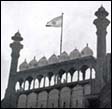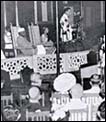'Astrologers discovered the morning of August 15 was inauspicious for transfer of power'
On August 15, 1947, the sun finally set on the British empire in India. It was a heady, and tumultuous day. Indians were delirious. They rejoiced on the streets, waved the saffron-white-green and wept over Nehru's speech.
Phillips Talbot, then South Asia correspondent for the Chicago Daily was a witness to this historic day. In a vivid letter to a friend in New York, he conveyed his impressions of India's first taste of freedom. Currently president emeritus at the Asia Society, New York, Mr Talbot granted Rediff On The NeT permission to use this letter from his archives.
20 Raj Mahal
Churchgate
Bombay, India
August 19, 1947
Dear Mr Rogers:
These have been five delirious, tumultuous days. In city after
city lusty crowds have burst the bottled-up frustrations of many
years in an emotional mass jag. Mob sprees have rolled from mill
districts to gold coasts and back again.
 Despite doubts about
the truncated, diluted form of freedom descending on India, the
happy, infectious celebrations blossomed in forgetfulness of the
decades of sullen resentment against all that was symbolised by
a sahib's sun-topi... in Delhi, Bombay, Calcutta and probably
other major cities, celebrating crowds numbered in the hundreds
of thousands.
Despite doubts about
the truncated, diluted form of freedom descending on India, the
happy, infectious celebrations blossomed in forgetfulness of the
decades of sullen resentment against all that was symbolised by
a sahib's sun-topi... in Delhi, Bombay, Calcutta and probably
other major cities, celebrating crowds numbered in the hundreds
of thousands.
Two common, astonishing bright threads ran through
the demonstrations nearly everywhere: a sudden, unpredicted return
to Hindu-Muslim amity and a warm outflowing of friendly expressions
toward Britain... The spontaneity of both is well established....
Some days earlier astrologers had discovered that the morning
of August 15-the day designated for the transfer of power was
an inauspicious time. Partly for this reason and partly because
they were well aware of the drama of the occasion, Congress leaders
decided on a midnight session of the Indian Constituent Assembly
to assume authority at the stroke of 12.
The programme was carried out to the letter inside the brightly-lit
hall. New national flags-saffron, white and green with a blue
Ashoka wheel of life in the center- hung in the chamber and against
the wall panels that formerly held portraits of British viceroys.
All India Radio and the BBC had their microphones and sound
cabins in place. Guests crowded the galleries and overflowed
onto the sides and back of the floor. Members' families, diplomats,
officials, press men, and all others who could wangle tickets
were there.
Inspired by the date, the hour and the crowd, Jawaharlal gave
another and perhaps the best of the sensitive, heart-warming,
destiny-conscious speeches that have marked his public life this
year... As the chimes of midnight were broadcast an excited Hindu
member blew the conch to call the gods to witness the occasion.
All members rose at the same moment to pledge themselves to the
service of India, and the Assembly was duly declared the sovereign
body of the just-born Dominion.
That was the scene inside the Assembly chamber. Outside, in the
streets leading around the circular building, new bedlam had broken
loose. Earlier in the evening Mildred and I had ridden with a
wild taxi driver down Chandni Chowk, one of the famous trading
streets of Asia. The happy crowds there had given me the first
inkling that this would not be like Karachi; they also furnished
the first tip that Hindus, Muslims and Sikhs were celebrating
happily together. Outside the Assembly building the scene was
the same. It was Time square on New year's eve.
 If that day, begun in Karachi and ended in Delhi, was a study
in contrasts, the next was a panorama of mass enthusiasms.
If that day, begun in Karachi and ended in Delhi, was a study
in contrasts, the next was a panorama of mass enthusiasms.
The official programme included the swearing in of the governor
general and the ministers at Government House, a special Constituent
Assembly meeting that culminated in the breaking of the national
flag over the Assembly building, a public flag-raising in the
afternoon, and an evening reception by the Mountbattens for several
thousand people.
The beginning, at least, was orderly. For hundred
invited guests gathered in the high-vaulted, marble-columned durbar
hall of the ex-viceroy's house, now called Government House. They
watched the Mountbattens, both consciously resplendent in white,
march in procession to the thrones where, only 20 weeks before,
the viscount had been inducted to the viceroyalty.
As before, the dress-uniformed bodyguard lancers stood at attention
and bugles rang through the hall. But this time Mountbatten had
come to surrender power. After being sworn in as a constitutional
governor general (his commission as viceroy having lapsed the
night before) he administered the oath of office to Nehru as the
first prime minister of self-governing India, and to other ministers.
The contrast between the admiral's white uniform, bedecked not
only with many medals but with the blue sash of the Order of the
Garter, and the dhoties and shirts worn by some of the
ministers was more striking than anything we had seen in Karachi.
As someone remarked, this looked like more than a transfer of
power from white-faced sahibs to brown-faced sahibs.
 Mountbatten, who in Karachi had formally relinquished authority
to Jinnah, seemed much more in his element in Delhi where, with
obvious popular support, he would remain for some months as governor
general. His inaugural speech to the Assembly reflected the warmth
and enthusiasm with which he had guided the Indian leaders to
this day. He was a symbol, yet the people were cheering something
far greater.
Mountbatten, who in Karachi had formally relinquished authority
to Jinnah, seemed much more in his element in Delhi where, with
obvious popular support, he would remain for some months as governor
general. His inaugural speech to the Assembly reflected the warmth
and enthusiasm with which he had guided the Indian leaders to
this day. He was a symbol, yet the people were cheering something
far greater.
Kind courtesy: New India Digest, a journal to promote a better understanding of modern India. Readers who wish to subscribe to New India Digest may write to India Digest Foundation, Sahaydri Sadan, Tilak Road, Pune 411030.
| 
